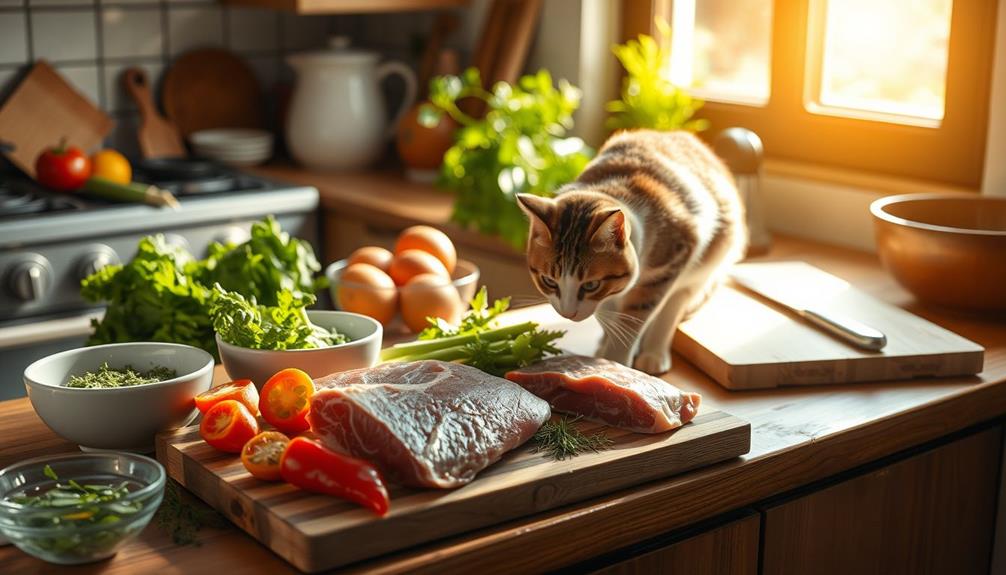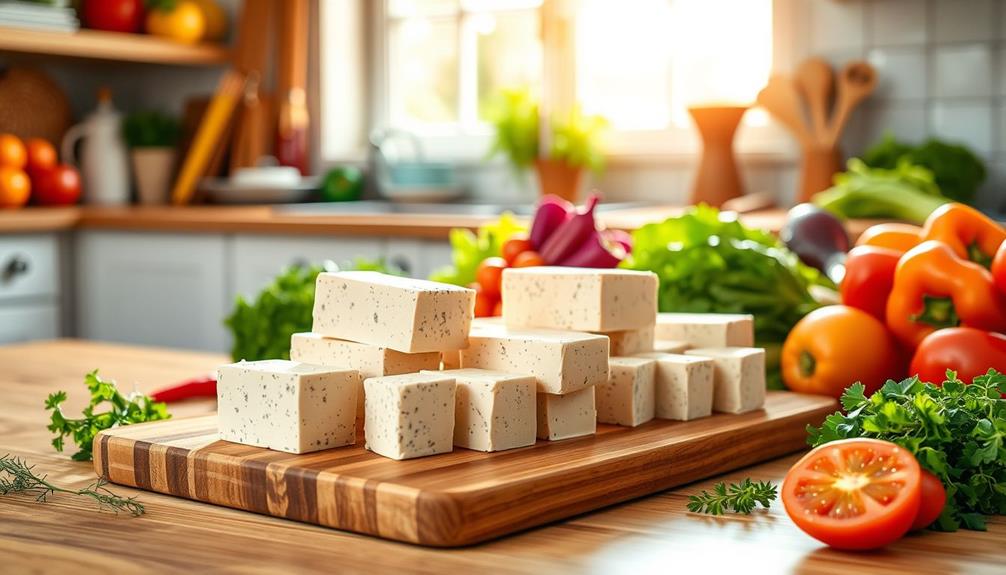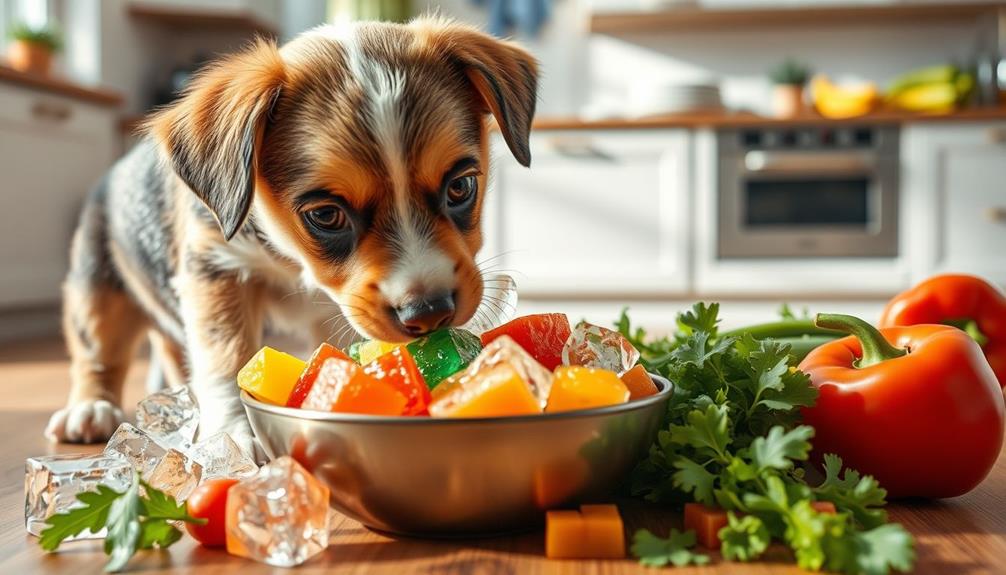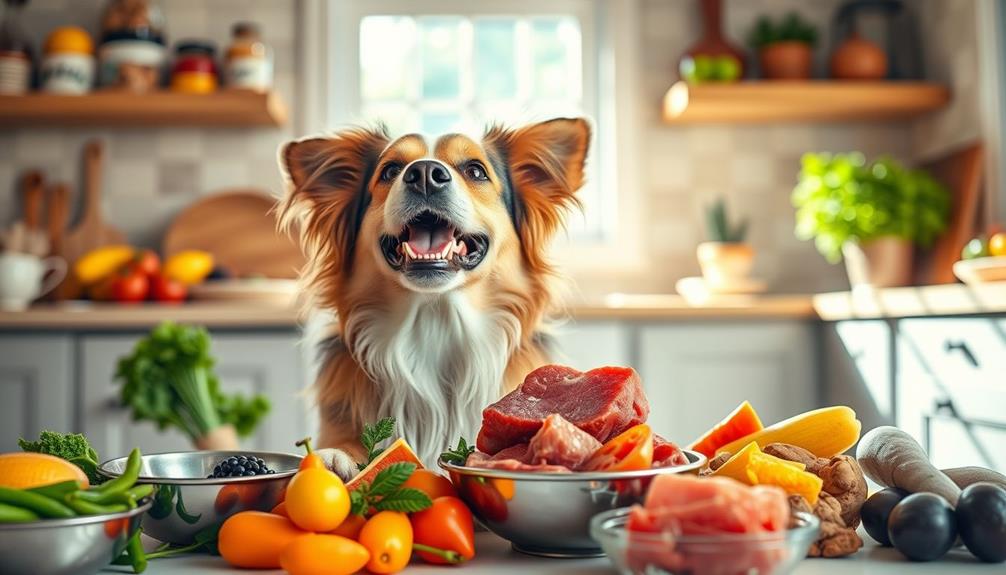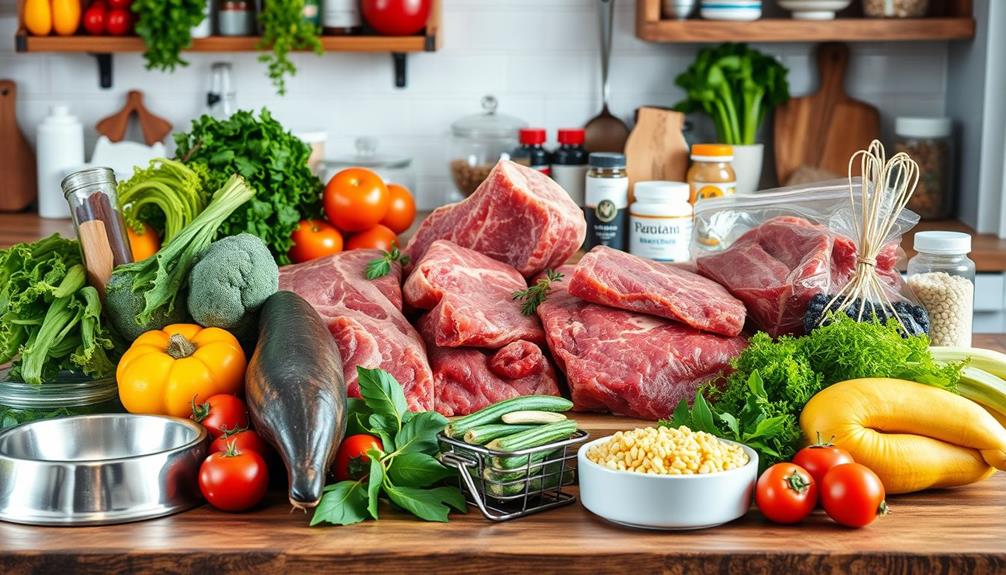To start your cat on a raw food diet, begin by replacing about 10% of their current food with raw options. Monitor their stool and adjust gradually, mixing raw food with their regular kibble to ease the shift. Serve raw meals at room temperature to enhance palatability. Choose high-quality meats and be patient as your cat gets used to the new flavors and textures. Verify that you're maintaining proper hygiene by using separate utensils for raw food. With these tips, you can help your cat thrive on a raw diet while exploring more essential information to support their journey. For added convenience, look into easy raw food recipes for cats to provide a variety of nutrient-dense options. Consider including organ meats, such as liver and heart, in the raw diet to mimic what your cat would eat in the wild. Research additional resources on the benefits of a raw food diet for cats to ensure you’re making the best choice for their health and well-being.
Key Takeaways
- Gradually introduce raw food by replacing 10% of the current diet, monitoring your cat's digestive comfort and stool consistency.
- Establish a consistent feeding routine, serving raw food at room temperature to enhance palatability and digestion.
- Choose high-quality meats and ensure a balanced diet to prevent nutrient deficiencies that could affect your cat's health.
- Consider various feeding methods, including pre-made frozen meals, powder mixes, or homemade options based on convenience and your cat's needs.
- Prioritize safety by sourcing raw food from accredited suppliers and maintaining hygiene through proper food storage and handling practices.
Health Benefits of Raw Diet
Switching your cat to a raw food diet can offer several health benefits that align closely with their natural dietary needs. One of the most significant advantages is improved nutrient absorption. Raw diets are rich in high-quality proteins and essential nutrients, allowing your cat to thrive and maintain ideal vitality.
Additionally, providing a diet free from fillers aligns with the principles of proper diet for pets, ensuring they receive only the best nutrition.
You'll likely notice enhanced weight management as well. Raw food provides nutrient-dense options with fewer fillers, helping your cat maintain a healthy weight without unnecessary calories.
Additionally, many cats experience fewer allergies and skin issues on a raw diet. The absence of artificial additives and grains, often found in processed foods, supports a healthier skin and coat.
The high protein content in raw diets also contributes to stronger muscles and an overall healthier body condition. Many owners report that their cats show increased energy levels and improved coat conditions after making the change.
These health benefits not only enhance your cat's physical well-being but can also lead to a happier, more active lifestyle. Shifting to a raw food diet is a step towards providing your furry friend with the nutrition they deserve.
Understanding Feline Behavior
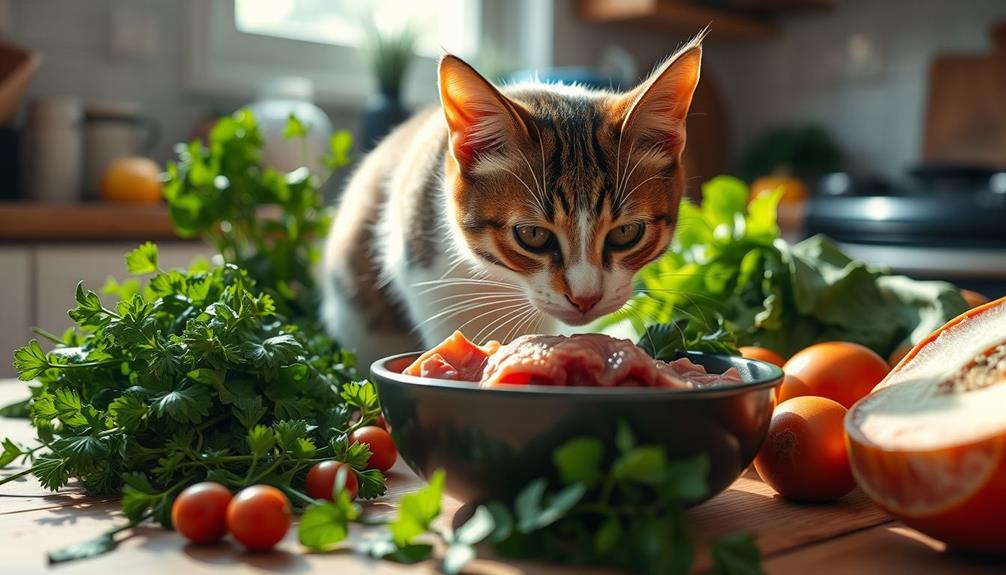
When shifting your cat to a raw food diet, understanding their instinctual eating habits is vital.
Cats are naturally cautious and may need time to get used to new textures and smells, so a gradual acclimatization process is essential.
Pay attention to their reactions and be patient as they adjust to this significant change in their diet.
Instinctual Eating Habits
Understanding your cat's instinctual eating habits is key to helping them shift to a raw food diet. As obligate carnivores, cats are naturally inclined to consume raw meat, which aligns with their evolutionary adaptations. Their acute senses of smell and taste guide them in identifying edible options, allowing them to discern safe foods.
It's important to recognize that the right diet can also promote overall health and well-being, as outlined in our gout nutrition guide. However, if your cat's been on a highly processed diet for a long time, it might struggle to recognize raw food as a viable option.
Feline finickiness often arises from exposure to commercial cat foods that contain flavor enhancers, which can alter their perception of food. This means your cat may hesitate to try raw options initially.
To facilitate a smooth changeover to a raw diet, you'll need to be patient and encouraging. It's important to remember that each cat is unique, and some may require more time than others to adjust.
Gradual Acclimatization Process
Introducing a raw food diet to your cat can feel like a delicate dance, especially given their instinctual finickiness. To make this change easier, a gradual acclimatization process is essential. Start by replacing just 10% of your cat's current diet with raw food. This small change allows you to monitor their stool consistency and digestive comfort, ensuring they adapt well to the new diet.
Additionally, considering your cat's overall health can enhance their experience; for instance, incorporating high-quality protein sources is crucial for energy levels and wellness, similar to how healthy dog snacks benefit canine companions.
You can also introduce raw food alongside their existing meals. Placing it next to kibble or wet food can help them get used to the new texture and flavor without overwhelming them. Patience is key; long-term consumption of commercial foods often contains flavor enhancers that may hinder acceptance of raw diets.
Establishing a consistent feeding routine can further enhance your cat's acceptance of feeding raw. Regular schedules help them feel secure and more open to trying new foods.
Gradual Introduction Process
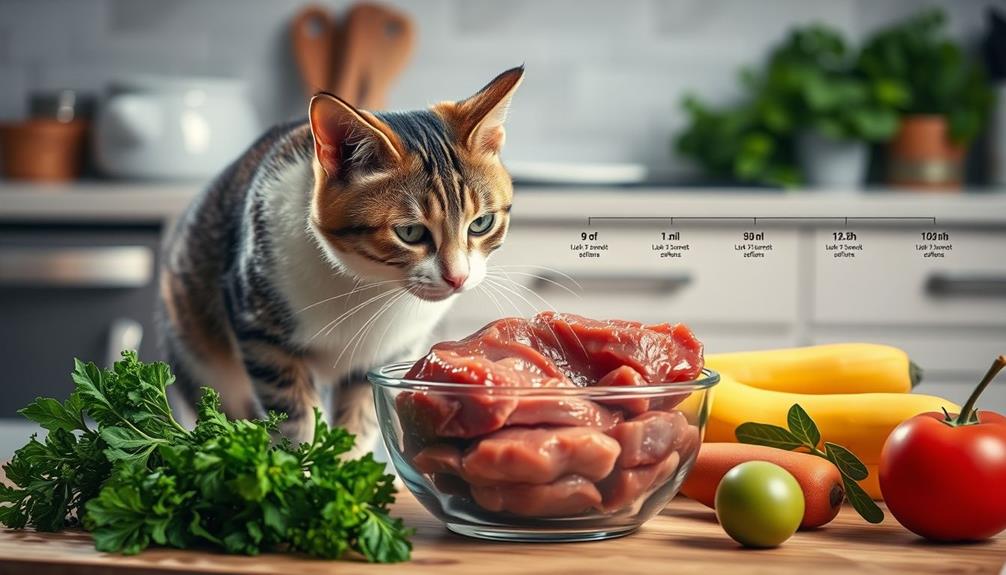
When starting your cat on a raw food diet, it's important to begin with a slow shift.
To guarantee your cat's overall health during this change, consider consulting a veterinarian who can offer tailored advice on nutritional needs and financial mistakes to avoid.
Start by replacing just 10% of their current food with raw options and keep an eye on their digestive health throughout the process.
Establishing a consistent feeding routine will help your cat adjust comfortably to their new diet.
Start Slow Transition
Starting with a small change can make a big difference when shifting your cat to a raw food diet. A slow adjustment is key to helping your cat adjust without digestive discomfort. This gradual approach can also promote better overall health, similar to how yoga can alleviate back pain.
Here's how to start:
- Replace 10% of their current food: Begin by introducing raw food into their diet, replacing just 10% of what they usually eat. This small amount allows their digestive system to adapt gradually.
- Monitor stool consistency: Keep an eye on your cat's stool. Firm stools indicate that your cat is adjusting well to the new diet. If stools become softer, slow down the adjustment; it's okay to take your time.
- Gradually increase raw food: As your cat's digestive health stabilizes, you can slowly increase the amount of raw food. Always verify their stools remain firm before adding more.
Establishing a consistent feeding routine can also help your cat adapt.
Monitor Digestive Health
Monitoring your cat's digestive health is essential during the change to a raw food diet. Start by replacing just 10% of your cat's current diet with raw food. This gradual introduction helps minimize digestive upset, allowing you to monitor their response effectively. Pay close attention to your cat's stool consistency; firmer stools generally indicate better digestive comfort.
If your cat's stools remain firm, you can slowly increase the proportion of raw food in their diet. However, if you notice any signs of digestive distress, such as loose stools or vomiting, revert to the previous diet until your cat stabilizes. Once they're comfortable, you can attempt the shift again.
Here's a simple table to help you track your cat's progress:
| Days | % Raw Food | Stool Consistency | Notes |
|---|---|---|---|
| 1 | 10% | Firm | Monitor closely |
| 3 | 20% | Firm | Continue to monitor |
| 7 | 30% | Firm | Gradually increase |
| 14 | 50% | Firm | Evaluate overall health |
Establish Feeding Routine
Establishing a consistent feeding routine is fundamental for your cat's change to a raw food diet. Start gradually to guarantee a smooth shift, preventing any digestive discomfort. Incorporating high-quality protein sources is important, as it mirrors the natural diet of cats and promotes their overall health, similar to how essential oils can support health.
Here's how to do it:
- Begin with 10% raw food: Replace just 10% of your cat's current diet with raw food initially. This minimizes the risk of gastrointestinal upset.
- Increase gradually: Over time, slowly increase the proportion of raw food while monitoring your cat's stool consistency. Aim for a balanced diet, making sure that your cat adjusts comfortably to the new regimen.
- Serve at room temperature: Allow the raw food to sit at room temperature before serving. This not only enhances palatability but also aids digestion, as cats typically prefer their food warm.
Throughout this process, be patient and observe your cat's behavior and preferences.
Quality meat is essential for raw feeding, so choose the best options available. Adjust your introduction process based on your cat's responses, ensuring they enjoy their new diet.
Temperature Considerations

When shifting your cat to a raw food diet, it's vital to take into account the serving temperature, as cats naturally prefer their meals at room temperature. This preference enhances palatability and encourages them to eat, making the change to raw cat food smoother.
To achieve the ideal serving temperature, simply remove the raw food from the fridge and let it sit out for 15-30 minutes before serving. Additionally, ensuring a clean feeding environment can help maintain both the food's quality and your cat's interest in their new diet, similar to maintaining air quality with air purifier maintenance dos and don'ts.
Feeding your cat cold food can deter them from eating, so it's important to warm the meals slightly without cooking them, preserving nutrient integrity. Serving raw food at the right temperature not only improves digestion but also increases acceptance of the new diet.
Always monitor your cat's response to the temperature of their food, as individual preferences may vary. Some cats might enjoy their raw meals slightly warmer or cooler. Adjust accordingly to find what works best for your feline friend.
Preparation for Raw Feeding

Preparing for a raw food diet for your cat involves a few essential steps to guarantee a smooth alteration. By setting up the right environment and gathering the necessary tools, you can make certain your cat's change is both safe and effective.
It's important to remember that just like with humans, making sure a balanced diet is vital for your cat's overall health, as poor nutrition can lead to various health issues nutrient deficiencies.
1. Gather Utensils: Collect a knife, cutting board, and scale to help with accurate food preparation and portioning. This makes certain you're serving the right amount of raw meat based on your cat's weight.
2. Select High-Quality Ingredients: Stock up on a variety of high-quality meats and other ingredients to create a balanced cat's diet.
It's vital to meet your cat's nutritional needs while providing them with the best possible food.
3. Budget and Community: Assess your budget for ongoing raw feeding costs. Prices vary by location and type of meat, so it's good to be prepared.
Additionally, join local raw feeding groups or online communities to share resources and experiences with other pet owners.
Feeding Methods Overview
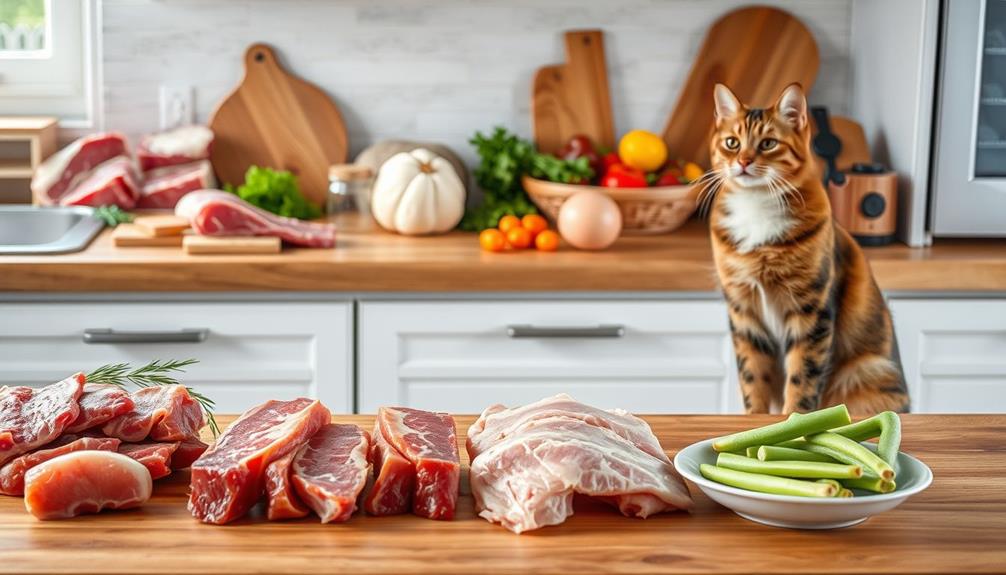
When it comes to feeding your cat a raw food diet, you have three main options: pre-made frozen meals, powder mix options, and homemade food preparation.
Each method offers a different level of convenience and involvement, so you can choose what fits your lifestyle best.
It's important to reflect on your cat's specific dietary needs and preferences, as well as the potential impact of emotional stability on their eating habits, similar to how BPD affects interpersonal relationships.
Let's take a closer look at these methods to help you decide the right fit for you and your feline friend.
Pre-Made Frozen Meals
Pre-made frozen meals offer a hassle-free way to introduce your cat to a raw food diet, requiring nothing more than thawing and serving. These meals are designed to provide balanced nutrition, ensuring your feline friend enjoys a variety of proteins without the stress of meal prep on your part.
Additionally, incorporating a diverse range of proteins can help mimic the natural diet of cats, which can be beneficial for their overall health and well-being. Research on nutritious ingredients, like high-quality protein sources, underscores the importance of selecting the right foods for your pet.
Here are three key benefits of pre-made frozen meals:
- Nutritional Variety: These meals often include proteins like turkey, lamb, beef, and chicken, promoting a well-rounded diet.
- Cost-Effective: Compared to homemade raw diets, pre-made options save you time and effort in sourcing quality meat and preparing meals.
- Convenience: Simply thaw and serve, making it easy to maintain a consistent raw food diet without complicated recipes.
When selecting pre-made frozen meals, be sure to check the quality of meat used. High-quality, species-specific ingredients without artificial additives contribute to your cat's health and well-being.
Just remember that availability can vary, so explore local pet stores or online suppliers for the best options. Your cat will thank you for making the switch!
Powder Mix Options
For a convenient and nutritious option, powder mix feeding allows you to easily incorporate raw ingredients into your cat's diet. Pre-made powder mixes are designed to provide a balanced diet, combining essential nutrients with fresh meat and egg yolks.
This method simplifies meal preparation, as you can mix the powder with the meat, then refrigerate or freeze the mixture for later use.
Using a pre-made powder mix is particularly beneficial if you're short on time but still want to guarantee your cat receives a healthy meal. It's also a cost-effective alternative to frozen meals while maintaining nutritional adequacy.
Just be sure to follow the manufacturer's instructions for the correct meat-to-powder ratio, as this is vital for keeping your cat's diet balanced.
With this approach, you won't have to compromise on quality or health benefits. Meal preparation becomes a breeze, letting you spend more time enjoying your cat's company rather than fussing over complicated recipes.
Homemade Food Preparation
Shifting to a homemade raw food diet for your cat opens up a variety of feeding methods that can suit your lifestyle and preferences. You can choose to feed raw food to cats in the form of prepared commercial raw food, or you can make your own raw food at home using a variety of protein sources like chicken, beef, or fish. Some people prefer to make larger batches of raw cat food and freeze individual portions, while others prefer to make smaller, fresh meals each day. Feeding raw food to cats allows you to have control over the quality and types of ingredients your cat consumes, and can also be a more natural and biologically appropriate diet for them.
You can choose from the following options:
- Pre-made frozen meals: These are a convenient choice. Simply thaw and serve. They provide a nutritionally balanced diet with a range of protein sources like turkey, lamb, beef, and chicken.
- Pre-made powder mixes: If you prefer a little more hands-on preparation, these mixes allow you to combine them with egg yolks and fresh meat. You can refrigerate or freeze the mixture, making it easy to serve later.
- Completely homemade raw food: This method involves sourcing and preparing every ingredient from scratch. While it can be labor-intensive, it gives you full control over your cat's diet.
Just be certain to measure and mix carefully to guarantee it's nutritionally balanced, keeping the right ratios of meat, organs, and bones.
Regardless of the method you choose, focus on creating meals that are both varied and nutritionally balanced to keep your cat healthy and happy.
Transitioning Tips
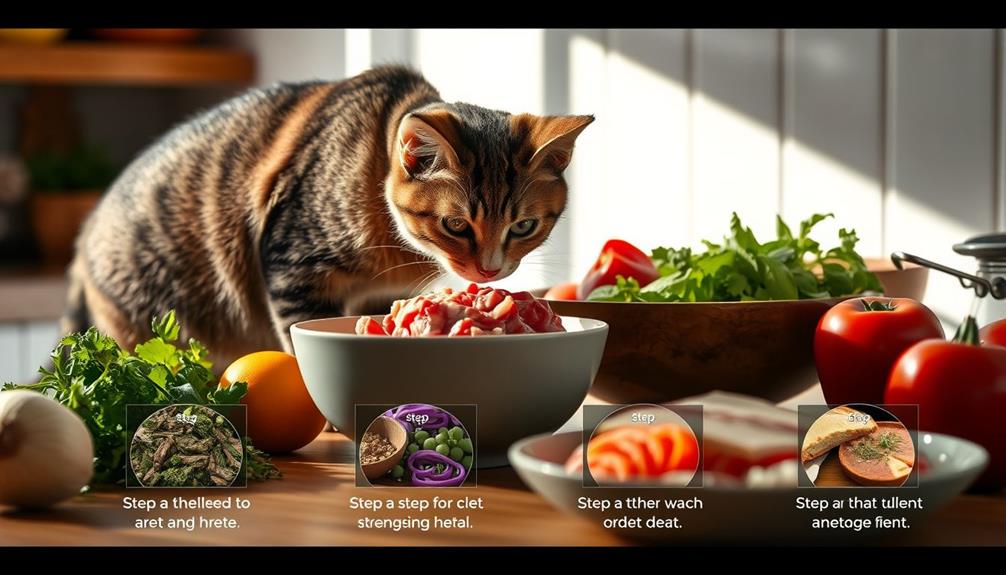
Shifting your cat to a raw food diet can be done smoothly with a few strategic steps. Start by replacing 10% of your cat's current diet with raw meals, gradually increasing the proportion as your cat adjusts. Keep an eye on their stool consistency to guarantee they're comfortable throughout the changeover.
If your cat is used to kibble, mix the raw food with it initially; this helps introduce familiar smells and flavors, easing them into the new diet. For cats that prefer wet food, place raw meals next to their usual wet food. This encourages sniffing and tasting without forcing them into a sudden alteration.
Establishing a consistent feeding routine is essential; it helps your cat acclimate and reduces anxiety related to meal changes.
Remember to be patient and flexible. Some cats may take longer to accept raw food, so adjust your approach based on their responses and preferences. You want this changeover to be a positive experience for your feline friend, making them more likely to embrace their new diet.
Nutritional Composition
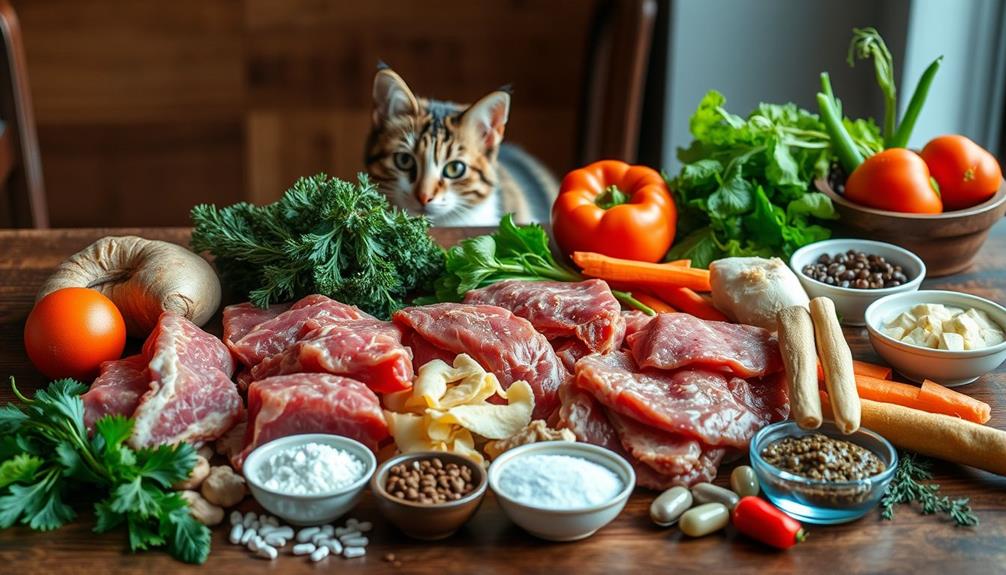
Understanding the nutritional composition of a raw food diet is key to ensuring your cat thrives. A high-quality raw diet for cats consists of 100% natural ingredients, providing the essential nutrients your feline needs. These nutrient-dense diets support overall health and well-being, making them a great option for your furry friend.
Here are three important components of the nutritional composition in raw diets:
- High-Quality Protein: Cats are obligate carnivores and require a diet rich in protein from sources like meat and organ meats. This helps maintain muscle mass and overall vitality.
- Healthy Fats: Essential fatty acids, such as omega-3 and omega-6, promote healthy skin and a shiny coat. They also play an important role in brain health.
- Vitamins and Minerals: Raw diets provide essential nutrients, including taurine from organ meats, essential for heart and eye health. Additionally, bone content supplies calcium, supporting strong bones and improved dental health.
Safety and Handling
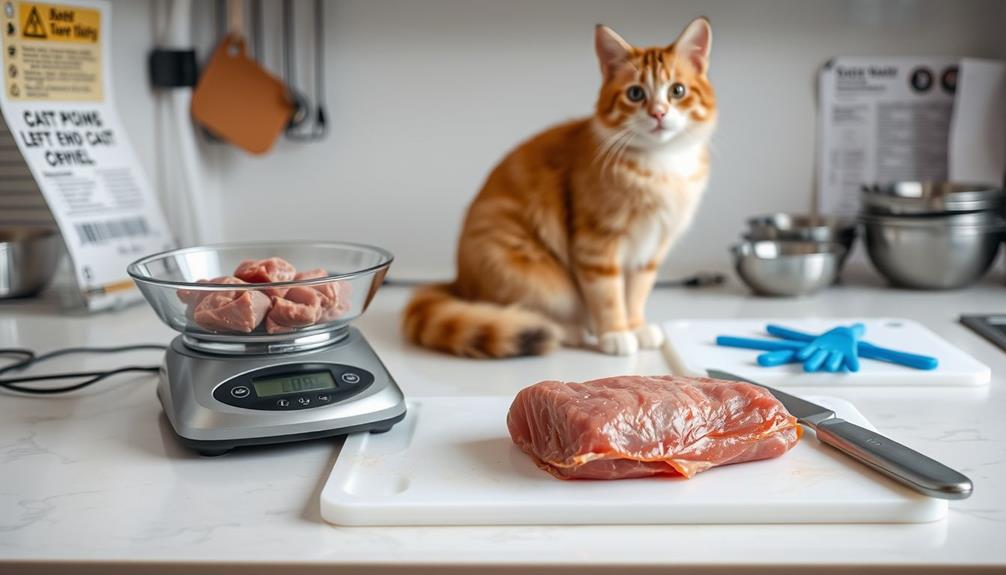
When it comes to feeding your cat a raw food diet, safety and handling are essential to prevent potential health risks. Start by ensuring all raw food is sourced from reputable suppliers with RawSAFE accreditation, which guarantees adherence to human food hygiene standards.
Use separate utensils and cutting boards to handle raw food, avoiding cross-contamination with other foods. When you store raw cat food, keep it in the refrigerator at temperatures below 40°F (4°C), and promptly refrigerate any uneaten portions to prevent spoilage.
Thaw frozen raw food in the refrigerator instead of at room temperature to minimize bacterial growth. Regularly clean and sanitize feeding areas and utensils to maintain hygiene and prevent foodborne illnesses. Here's a quick reference table for safety and handling:
| Action | Tips |
|---|---|
| Sourcing | Choose RawSAFE accredited suppliers. |
| Handling | Use separate utensils and cutting boards. |
| Storing | Keep food below 40°F (4°C) and refrigerate leftovers. |
Community Resources and Support
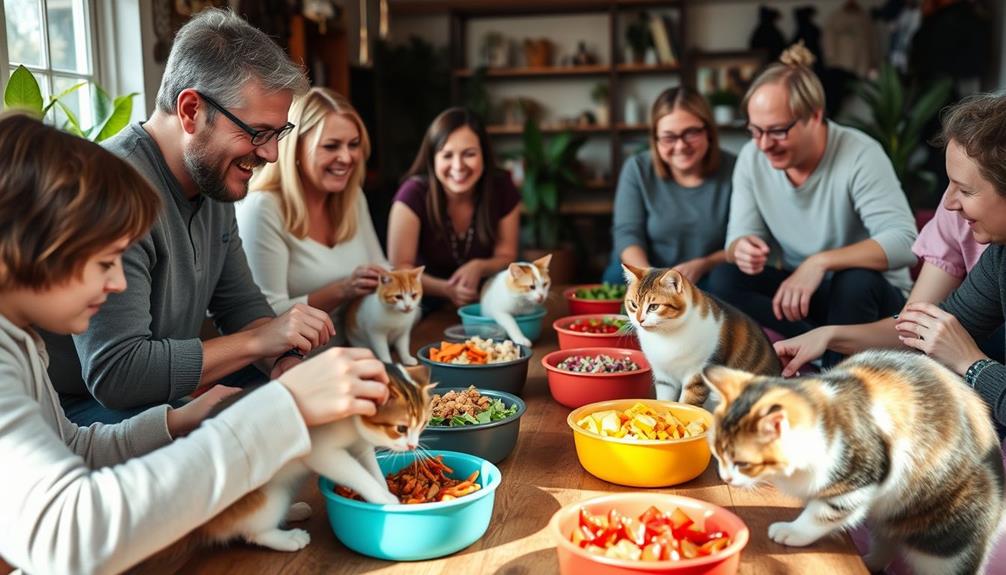
Finding community resources and support can make a significant difference when altering your cat to a raw food diet. Engaging with others who share your passion can provide invaluable insights and encouragement throughout the change.
Here are three ways you can tap into these resources:
- Join Online Communities: Platforms like The Pack offer spaces for cat owners to exchange experiences, tips, and advice on adapting to a raw food diet.
- Utilize Social Media: Follow pages dedicated to raw feeding; they often share articles on the benefits of a raw food diet and how to monitor your cat's weight effectively.
- Connect with Local Groups: Many areas have raw feeding groups that provide resources and access to experts. These connections can help answer specific questions and address concerns you might've during the change.
Frequently Asked Questions
How Do I Transition My Cat to a Raw Food Diet?
To shift your cat to a raw food diet, start by replacing 10% of their current food with raw. Gradually increase this amount, monitoring their reactions, and consult your vet for tailored advice.
What Should I Add to My Cat's Raw Food?
You should add raw meaty bones, muscle meats, and organ meats to your cat's diet. Don't forget supplements like salmon oil and probiotics for balanced nutrition, ensuring your cat gets all essential nutrients for ideal health.
Why Don T Vets Recommend a Raw Diet for Cats?
Ever wonder why some vets hesitate to endorse raw diets for cats? They worry about bacterial risks, nutritional imbalances, and potential dental or gastrointestinal issues, emphasizing that careful planning and veterinary guidance are essential for your pet's health.
Can I Feed My Cat Only Raw Food?
Yes, you can feed your cat only raw food, but guarantee it's balanced. Include muscle meat, organs, and bones, and monitor their health closely. Gradually shift to prevent digestive issues and consult your vet regularly.
Conclusion
Embracing a raw food diet for your cat can open the door to a world of vibrant health and happiness. Like a garden blooming with life, you'll watch your feline thrive with energy and vigor. By taking the time to convert thoughtfully and safely, you're not just changing their food—you're nurturing their very essence. So, roll up your sleeves, plunge into this adventure, and let your cat flourish in the natural way they were meant to.

